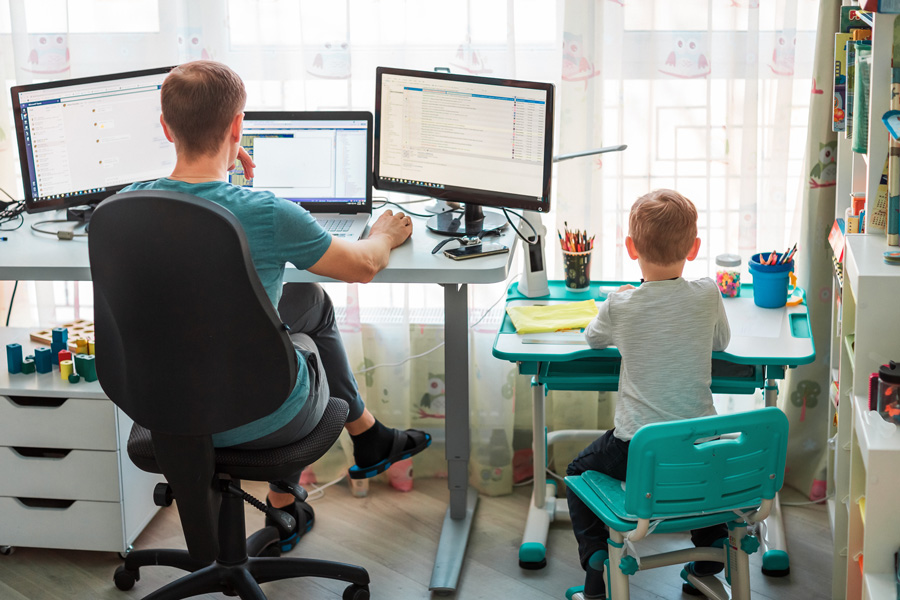Ways to Manage Stress In (and Out of) the Workplace

In the past few years alone, the shifts in the ways we work have changed dramatically. As the global pandemic pushed companies to restructure their organization and leave traditional workplace routines behind for a more modern, flexible workplace. While some are still heading to the office, many are now working from home, which means that co-workers who were once sitting at desks next to each other can now be states, countries, and several time zones apart. This shift in the global workforce is capable due to our increased confidence in our ability to move the entirety of our work online. Tools such as Slack, Google Workspace, and Microsoft Teams allow for this new normal to be accessible for everyone and every company.
Managing Stress While Working From Home
With such a dramatic change in where we work, how we work, and how the companies we work for interact with us, many people are finding it difficult to manage stress in the same ways that they used to. New work environments and a rapidly changing world put pressure on employees to adapt, change up their routine, and figure out how to navigate a completely new working landscape on their own. A study from the APA shows that 3 in 5 employees find that work-related stress negatively impacts performance. With the compounding stressors arising from a global pandemic in 2020, it isn’t surprising that workplace stress is on the rise.

Jason Cosper, DreamHost’s resident WordPress expert, has been working remotely from home for over a decade. In his recent presentation at Big Orange Heat’s WordFest Live, Jason talked about the learning and challenges of working from home. In our increasingly digital world, when we identify how to better manage stress when working remotely, we can apply the same practices at the workplace as well. A 2020 study by FlexJobs and Mental Health America shows that 75% of remote workers share that they experience stress and burnout at work. More than 37% report working longer hours than they previously did.
Related: Stay Focused While Working from Home
It sounds a lot like the current workforce is scrambling to adjust to the new world ways, and finding themselves exhausted by the inability to create real work/life balance amid so much change. Thankfully, Jason has been working out the kinks in his own relationship to work for many years and has developed some helpful tips to managing stress both at the workplace and as a remote employee. Keep in mind that prioritizing your mental health is not only an important and necessary self-care practice but essential for companies who strive for longevity in their productivity.
6 Tips to Better Manage Work-Related Stress
1. Prioritize” You” Time First
Just as many financial advisors would insist that you “pay yourself first” by putting a portion of your paycheck into savings as soon as the money hits your bank account before you address bills and expenses– the same goes for time. If you don’t pay yourself in time first, then your time will ultimately be drained by whatever urgent work matter is needed at the moment.
The best way to ensure you are prioritizing your time for yourself is to make an intentional effort to block off sections of your day that give you the breaks you need to refresh and refocus. Schedule lunch breaks in your calendar (and actually take them!). Jason likes to set up a 15 min “busy time” buffer in his calendar at the beginning and end of his days to allow him that extra minute to breathe, let the coffee hit, and settle into his workspace without the immediate meeting. This buffer time also prevents co-workers from setting up obligations at the very start or end of your day and provides a more defined workday boundary that allows you to gradually flow into and out of your day.
The globalization of the workforce for many companies means that working hours vary from person to person, it can be easy to get caught up in trying to manage several different time zones when the best way to be productive is to focus on your personal relationship to time and work and let other people figure out how that works with their schedule.
It may be tempting to spend your entire workday sitting at your desk, whether you are at home or the office. Hustle culture can sneak up on us and trick us into thinking that working without taking a break is the way to prove how good we are at our job. This backward type of thinking will wreak havoc on our mental health and be detrimental to our productivity in the end.

Take your scheduled breaks, no matter how busy you are. Maybe it’s as simple as taking a walk during your lunch hour, going for a quick run at the 3 pm marker, taking a nap on the couch, playing with your pet, or spending time with your family. Whatever it is that prioritizes time for you to disengage, relax, and be present for a moment during your workday helps to reset your mind and give you a fresh perspective.
2. Schedule Everything
Your calendar is likely always being updated with meetings and deadlines, maybe even future vacation days and exciting events. But as important as it is to use a calendar to organize and remember work obligations, you can also utilize your calendar as a tool to hold you accountable to your promise to prioritize yourself.
Proactively look at your calendar and set up recurring events that block off sections of time that provide a balanced structure to your day. The thing about our modern ways of coworking is that regardless if we are in the office or working remotely, we are always accessible. With notifications pinging every minute, last-minute meetings popping up on the calendar, and a global workforce that easily entices a 24/7 on-call availability.
Strategic planning and smart scheduling are highly effective ways to minimize burnout and mitigate work-related stress. It was recently discovered that 46% of work stress is experienced due to an overwhelming workload. Especially if we work remotely, scheduling office hours are non-negotiable. Work from home does not equate to work forever.
One of the leading causes of burnout is long stretches of work without a break, and if you aren’t scheduling your breaks into your calendar then likely, you aren’t taking them. For this, Tony Schwartz, founder of the Energy Project – an organization dedicated to enabling companies to perform better, suggests “intermittent renewal.”
This technique suggests that taking a break to disengage from work about every 90-minutes can help alleviate the stressors that cause burnout. This is especially essential for breaking up workloads that could become monotonous due to a repetitive nature, or where there is a higher likelihood of becoming unmotivated and detached. Scheduling your intermittent renewal before it is necessary is the key to smart scheduling that will lead to a higher rate of success.
3. Keep Work Apps On Work Devices
Resist putting all of your work communications on your personal devices. It may be super tempting to add your work email to your phone, but it is completely unnecessary. You don’t need to be able to receive an email over dinner or check your Slack from bed first thing in the morning.

Jason suggests that the only work tool that you should have on your personal devices is your work calendar, that way you can check it to make sure you can schedule your personal life seamlessly and balance it with work. It is found that using the correct organizational tools to manage your calendar can improve time management by up to 38%! Depending on the type of inner office tools that your company uses, you can set up your google calendar or other calendar apps on your phone to give you the ability to reference your work schedule outside of work. Since the calendar is not a communication tool it is easy to check in on and put back down without disrupting your out-of-office flow.
“Once work takes up residency in a part of your life, it takes a real, concerted effort to evict it. Boundaries are no longer up to the task. We need guardrails.”
— Out of Office by Anne Helen Petersen & Charlie Warzel
We live in a culture of constant communication, so it is incredibly tempting to reply to a slack message or an email when you see it come in. In our digital age, we have a phone attached to our hands for the majority of our day. The perception that we should be accessible at any time is hovering around us all, especially as we try to navigate new remote working environments.
Jason reminisces about the early days of his remote working life and how he thought that to prove his dedication to his team, he had to be available all the time. He remembers feeling like a doormat, as he worked 12+ hours a day regularly and still found that he would be contacted outside of working hours with questions and obligations.
“You cannot change when someone sends you an email,” says Jason, “but you can change when you reply to it.”
Once Jason decided to establish his boundary of only using work-related devices and apps during his designated working hours, he was able to rebuild his working relationships with others and restructure his days to be more balanced and productive. Without his work email on his phone, he was not tempted to reply to a colleague until the next working day and found that the practice of maintaining this boundary freed up his time for himself, to prioritize his work, and reduce his overall stress.
4. Establish Routines
Routines are a tried and true stress management tool and go hand in hand with scheduling to create a protective cushion for your daily stressors. Some people are naturally better or have the accessibility to establish routines from the jump, but if that is something that doesn’t come easily to you, there are simple ways to start implementing them today.
Jason discusses how a great way to build a healthy routine while working from home is to mimic a commute that will help signal to your mind and body that work is beginning or ending. He says that adding a short walk right before you sit down to work and right after the end of your day is not only a great way to get some fresh air and exercise but helpful to your stress levels that work must stay within the boundaries of these time limits and outside of this routine is where you can fully embrace rest and relaxation.
There are the recommended routines that every healthcare professional would advise are followed to ensure that you are not only mitigating stress levels but also keeping your physical health in good shape:
- Stay active and get regular daily exercise
- Make sure that you are well-rested
- Eat healthy meals on a regular schedule
- Set realistic goals
- Stay in touch with friends and family members
Related: Create ‘Watercooler Moments’ While Working Remotely
The key to establishing a healthy routine is not only to apply smart scheduling techniques but to also prioritize routines that allow you to fully disengage from any work-related stressors. This means avoiding breaks that only move from one screen to another, staying at your desk to eat lunch, or doom scrolling through your phone.
If you have a daily physical movement routine already established like running or yoga, be sure to keep that as a priority, especially in times of heightened busyness or around stressful deadlines. Advocate for yourself by sticking to your dedicated routines, and apply this across all areas of your life. Whether you work from home or go into an office, a routine can greatly reduce the amount of work-related stress you might face as well as lower the chances of becoming burnt out.
5. Be Mindful of Others’ Time
Life happens. We are all just here living a human experience and we have to learn how to build our working life around these experiences. How we establish boundaries with the people we work with and also approach other people’s situations with empathy, are helpful to creating a workplace environment that is low stress and supportive.
“My act of love on a Friday afternoon is scheduling every email I answer to send on Monday morning.”
— Austin Kleon
One of Jason’s most useful and empathetic practices that he actively engages in, is the ‘scheduled send” feature in Gmail. Any mail that he responds to or sends after 5 pm – any day of the week – gets scheduled to go out at 9 am the following morning. This seemingly small adjustment does not only help him stay within his scheduled work time allotment but it also takes the pressure of the receiver to perpetuate a potentially endless back and forth of communication and frees them up to disengage from their work.
Don’t wait until the people you work with give you feedback to recognize their communication boundaries, take the initiative to consider other people’s time while you are scheduling your own. Tying this all together with the previous tips for managing stress, if you want to schedule a meeting and you check the other person’s calendar and see they have focus time scheduled in the morning, a run in the mid-afternoon and are leaving their desk early to go pick-up their kids, being mindful means taking all of these into consideration when reaching out and trying to find time to meet. Smart scheduling, prioritizing self-time, and being mindful of others would help you discern the best time to set up a meeting with your colleague and further healthy, happy, and supportive working relationships.
6. Know When to Say “No”
Respectfully of course.
Burnout is real, and it’s draining on people, resources, relationships, and productivity. A company cannot (and should not) be pushing its employees to a state of burnout, but it happens, even in the healthiest of working environments.
“We don’t work from home because work is what matters most. We work from home to free ourselves to focus on what actually does.”
— “Out of Office” by Anne Helen Petersen & Charlie Warzel
Especially if you are working remotely. Because no one can see you, you do not have the same common signals that other people can interpret daily, such as a closed office door, being away from your desk, spending all day in a conference room, etc… This gives the illusion that you are potentially always available. We can’t expect people to read our minds, especially in a virtual work environment. There are clues to help us, like status emojis, and blocking off time in calendars, but even that cannot accurately represent your workload and emotional state.
Establishing healthy and communicative relationships with your colleagues and supervisors will help to approach any stressful situation with more ease. If you have an open and honest dialogue with your coworkers around work stressors, that will hopefully help mitigate any potential burnout.
How to Say ‘No’
- Mention a specific urgent project that is taking up all your time.
- Suggest a different timeline for any proposed extra work.
- Don’t use the word ‘no’ directly, but create a space for compromise.
- Don’t be apologetic or feel guilty, advocating for yourself is important.
- Point out any risks of missing deadlines due to an overloading work schedule.
- Mention what you need help with to finish the most urgent task.
- If you are nervous about a verbal refusal, ask for time to think about it and then reply mindfully, try using one of the examples from this list to help guide you.
Unfortunately, 21% of workers say they were able to have open, productive conversations with HR about solutions to their burnout. While 75% of workers have experienced burnout, with 40% saying they’ve experienced burnout specifically during the pandemic. With statistics like these, it’s clear that workers have a hard time speaking up and being able to say “no” when necessary. A job is a community and hopefully strengthening relationships within that community can create the space to speak up when stress is high and burnout is on the horizon.
Your Mental Health Matters
When Jason began his remote work journey, he found himself often in a state of trial and error when it came to managing stress and his new work from home environment. Figuring out the best ways for him to navigate his physical workspace while sharing a one-bedroom apartment with his wife, learning that keeping his work computer on at all times means he’s working all the time. He was caught up in the cycle of thought that overworking was a sign to his team that he was dedicated, he wasn’t able to say no, and was always available even when it cut into his valuable personal time. He was working himself into a spiral of stress that was affecting everything around him.
“It wasn’t until I suffered a bout of stress-induced Bell’s Palsy — which, by the way, looked an awful lot like a stroke and resulted in thousands of dollars in the emergency room and ambulance bills — that I realized that I needed to pay myself first with regards to my time,” Jason shares.
In Jason’s case, his mental health stressors literally translated into a physical health crisis. According to a study by Gallup, burned-out employees are 63% more likely to take a sick day and 2.6 times as likely to be actively seeking a different job.
While we are generally talking about the personal responsibilities that you can take to manage your stress levels at work, there is a broader context to the conversation. Compounding global crises all over the world have sparked an uptick in mental health struggles for everyone everywhere. In the last few years, sixty-one percent of remote workers and 53% of on-site workers now find it more difficult than before to “unplug” from work during off-hours.
This shows that as a community we should make a concerted effort to amplify mitigation strategies to prevent burnout, manage stress, and support anyone who is struggling with their mental health. If you are experiencing signs of burnout, don’t be ashamed, reach out to your HR department for resources and advice on how to work through your hardships, or use available time-off to give yourself a responsible reset. Whatever strategies you use to help manage work-related stress, remember that you matter, your mental health is a priority, and you are not alone.
Get Content Delivered Straight to Your Inbox
Subscribe to our blog and receive great content just like this delivered straight to your inbox.